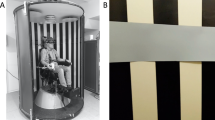Summary
Background: The recommendations of the German Society of Ophthalmology (DOG) concerning the examination of candidates or holders of a driving licence allow a maximum time interval of 1 s for identifying a single Landolt-C for normal individuals as well as for patients with nystagmus. The aim of this study was to determine whether visual acuity decreases with shortening of the exposure time.
Patients and methods: We measured the visual acuity of 18 patients with manifest nystagmus and 26 normal individuals with single Landolt-C at exposure times of 10 s, 1 s, 0.25 s and 0.1 s.
Results: Visual acuity dropped significantly at exposure times of 1 s in the group of patients with nystagmus (P = 0,01). In normal individuals, visual acuity decreased significantly only at exposure times below 1 s.
Conclusion: Determining visual acuity according to the recommendations of the DOG shows a significant drop of visual acuity in nystagmus patients, but not in normal individuals. Applying the maximum time limit of 1 s exposure time to these patients will ensure that they will be able to identify traffic signs quickly and orient themselves safely.
Zusammenfassung
Hintergrund: Die Empfehlungen der Deutschen Ophthalmologischen Gesellschaft (DOG) zur Fahreignungsbegutachtung fordern bei der Visusprüfung von Nystagmus-Patienten eine Lesezeit von maximal 1 Sekunde pro Landoltring. In dieser Studie sollte geprüft werden, ob die Sehschärfe in Abhängigkeit von der Darbietungszeit sinkt, und ob Normalpersonen und Nystagmus-Patienten durch diese Vorschriften in der Fahreigungsbegutachtung benachteiligt werden.
Patienten und Methode: Es wurde bei 18 Patienten mit manifestem Nystagmus und bei 26 Normalpersonen die Sehschärfe mit einzelnen Landoltringen mit Darbietungszeiten von 10 s, 1 s, 0,25 s und 0,1 s bestimmt.
Ergebnisse: Bei Patienten mit Nystagmus verschlechterte sich der Visus bei 1 s Darbietungszeit signifikant im Vergleich zu dem Visus bei 10 s Darbietungszeit (p = 0,01). In der Gruppe der Normalpersonen konnte ein signifikanter Visusabfall erst bei Darbietungszeiten unter 1 s gemessen werden.
Schlußfolgerung: Obwohl Nystagmus-Patienten bei der Visusprüfung mit einer Darbietungszeit von einer Sekunde signifikant schlechtere Ergebnisse als Normalpersonen zeigen, sollte für die augenärztliche Fahreignungsbegutachtung der Grenzwert von 1 s Darbietungszeit beibehalten werden. Nur so kann gewährleistet werden, daß Hinweisschilder und andere Verkehrssituationen ausreichend schnell erkannt werden können.
Similar content being viewed by others
Author information
Authors and Affiliations
Rights and permissions
About this article
Cite this article
von Boehmer, H., Kolling, G. Effect of exposure time using single Landolt-rings on visual acuity in normal individuals and in patients with nystagmus. Ophthalmologe 95, 717–720 (1998). https://doi.org/10.1007/s003470050341
Published:
Issue Date:
DOI: https://doi.org/10.1007/s003470050341




